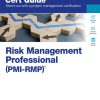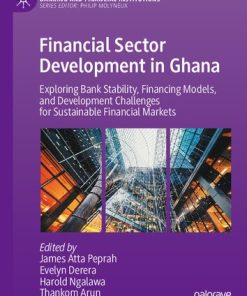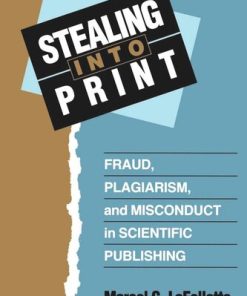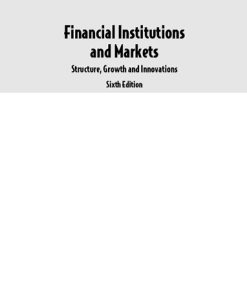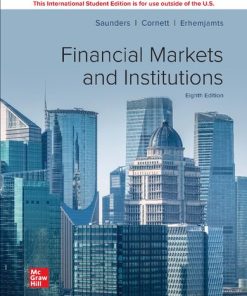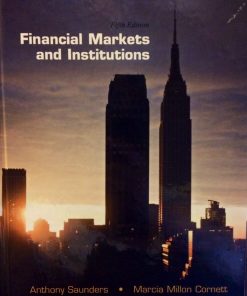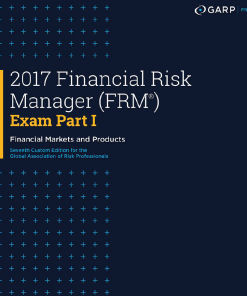Corruption and Fraud in Financial Markets Malpractice Misconduct and Manipulation 1st edition by Carol Alexander 1394178158 9781394178155
$50.00 Original price was: $50.00.$25.00Current price is: $25.00.
Corruption and Fraud in Financial Markets: Malpractice, Misconduct and Manipulation 1st edition by Carol Alexander – Ebook PDF Instant Download/DeliveryISBN: 1394178158, 9781394178155
Full download Corruption and Fraud in Financial Markets: Malpractice, Misconduct and Manipulation 1st edition after payment.

Product details:
ISBN-10 : 1394178158
ISBN-13 : 9781394178155
Author : Carol Alexander
Identifying malpractice and misconduct should be top priority for financial risk managers today
Corruption and Fraud in Financial Markets identifies potential issues surrounding all types of fraud, misconduct, price/volume manipulation and other forms of malpractice. Chapters cover detection, prevention and regulation of corruption and fraud within different financial markets. Written by experts at the forefront of finance and risk management, this book details the many practices that bring potentially devastating consequences, including insider trading, bribery, false disclosure, frontrunning, options backdating, and improper execution or broker-agency relationships.
Corruption and Fraud in Financial Markets: Malpractice, Misconduct and Manipulation 1st Table of contents:
Chapter 1: Introduction
References
Part I: What Are Manipulation and Fraud and Why Do They Matter?
Chapter 2: An Overview of Market Manipulation
2.1 Introduction
2.2 Definitions of Market Manipulation
2.3 A Taxonomy of the Types of Market Manipulation
2.4 Research on Market Manipulation
2.5 Summary and Conclusions
References
Notes
Chapter 3: A Taxonomy of Financial Market Misconduct
3.1 Introduction
3.2 Challenges in Research on Financial Market Misconduct
3.3 Defining Financial Market Misconduct
3.4 Defining Financial Fraud
3.5 Conclusion
References
Notes
Chapter 4: Financial Misconduct and Market-Based Penalties
4.1 Introduction
4.2 Notable Cases of Financial Reporting Fraud
4.3 Financial Reporting Misconduct and Legal Redress
4.4 Evolution of US Financial Regulations
4.5 Legal versus Market-Based Penalties for Financial Misconduct
4.6 Firm-Level Penalties for Corporate Financial Misconduct
4.7 Individual-Level Penalties for Corporate Financial Misconduct
4.8 Causes, Risks, and Moderators of Financial Misconduct
4.9 Other Non-Financial Misconduct
4.10 Concluding Remarks
References
Notes
Chapter 5: Insider Trading and Market Manipulation
5.1 Introduction
5.2 Regulatory Framework on Insider Trading and Market Manipulation
5.3 Recent Examples of Market Manipulation and Insider Trading
5.4 Conclusions
References
Notes
Chapter 6: Financial Fraud and Reputational Capital
6.1 Financial Frauds in the 2000s
6.2 The Effects of Fraud Revelation on Firm Value and Reputational Capital
6.3 The Effects of Fraud Revelation on Shareholders and Managers
6.4 Why Do Managers Do It? Motives and Constraints
6.5 Proxies and Databases Used to Identify Samples of Financial Statement Misconduct
6.6 Conclusion: Reputation, Enforcement, and Culture
References
Notes
Part II: How and Where Does Misconduct Occur?
Chapter 7: Manipulative and Collusive Practices in FX Markets
7.1 Introduction
7.2 Different Types of FX Order
7.3 The Unique FX Market Structure
7.4 Examples of Manipulative and Collusive Practices in FX Markets
7.5 The Reform Process
References
Notes
Chapter 8: Fraud and Manipulation within Cryptocurrency Markets
8.1 Introduction
8.2 Why Do Fraud and Manipulation Occur in Cryptocurrency Markets?
8.3 Pump and Dumps
8.4 Inflated Trading Volume
8.5 Exchange DDoS Attacks
8.6 Hacks and Exploitations
8.7 Flash Crashes
8.8 Order Book-Based Manipulations
8.9 Stablecoins and Tether
8.10 Summary and Conclusions
References
Notes
Chapter 9: The Integrity of Closing Prices
9.1 Why Closing Prices Matter
9.2 Painting the Tape and Portfolio Pumping
9.3 ‘Bang-the-Close’ Manipulation: The Response of Financial Intermediaries
9.4 Stock Price Pinning on Option Expiration Dates
9.5 Conclusion: Lessons for the Regulation and Design of Financial Markets
References
Notes
Chapter 10: A Trader’s Perspective on Market Abuse Regulations
10.1 Introduction
10.2 Getting the Trading Edge
10.3 A Typical Trader’s Market Window
10.4 Wash Trades
10.5 High Ticking/Low Ticking – Momentum Ignition
10.6 Spoofing
10.7 Layering
10.8 Smoking
10.9 Case Study: Paul Rotter a.k.a. ‘The Flipper’
10.10 The Innocent and the Guilty
10.11 What Are Exchanges Doing to Prevent Market Abuse?
10.12 What Are Trading Companies Doing to Prevent Abuse?
10.13 Will There Be an End to Market Abuse?
Notes
Part III: Who Are These Scoundrels?
Chapter 11: Misconduct in Banking: Governance and the Board of Directors
11.1 Introduction
11.2 Literature Review
11.3 Research Design
11.4 Empirical Results
11.5 Conclusion
References
Notes
Chapter 12: Misconduct and Fraud by Investment Managers
12.1 Introduction
12.2 Related Research
12.3 The Investment Advisers Act of 1940 and Mandatory Disclosures
12.4 Data
12.5 Predicting Fraud and Misconduct
12.6 Predicting the Initiation vs. the Continuance of Fraud
12.7 Firm-Wide Fraud vs. Fraud by a Rogue Employee
12.8 Out-of-Sample Prediction and Model Stability
12.9 Policy Implications and Conclusions
Appendix: Variable Definitions
References
Notes
Chapter 13: Options Backdating and Shareholders
13.1 Introduction
13.2 Stock Return Patterns around Option Grants
13.3 The Backdating Practice
13.4 Media Coverage, Restatement, and Investigation
13.5 Stock Market Reaction to Public Revelations of Backdating
13.6 Investor Reaction to (and Anticipation of) Public Revelations
13.7 Other Types of Misbehaviour Related to Option Grants
13.8 Connections with Questionable Practices by Corporate Executives and Other Agents
13.9 Conclusion
References
Notes
Chapter 14: The Strategic Behaviour of Underwriters in Valuing IPOs
14.1 Valuing IPOs
14.2 The Underwriter’s Incentives in the Valuation of IPOs
14.3 Literature Review
14.4 Sample, Data, and Methodology
14.5 Results
14.6 Conclusions
References
Notes
Chapter 15: Governance of Financial Services Outsourcing: Managing Misconduct and Third-Party Risks
15.1 Introduction
15.2 The Four Components in Outsourcing
15.3 The Interaction between Contracting and Monitoring
15.4 Governance Mechanisms to Detect Misconduct in Financial Outsourcing
15.5 Conclusion
References
Notes
Part IV: Detection and Surveillance of Financial Misconduct
Chapter 16: Identifying Security Market Manipulation
16.1 Introduction
16.2 Background Legislation
16.3 Attributes of Manipulation
16.4 Detection Algorithms
16.5 Conclusion
Notes
Chapter 17: The Analytics of Financial Market Misconduct
17.1 Introduction
17.2 Financial Economic Analysis
17.3 Quantitative Techniques
17.4 Conclusion
References
Notes
Chapter 18: Benford’s Law and Its Application to Detecting Financial Fraud and Manipulation
18.1 Introduction
18.2 Benford’s Law and Generalizations
18.3 Usage of Benford’s Law for Detecting Fraud and Deviant Behaviour
18.5 Policy Implications
18.6 Summary, Limitations, and Outlook
References
18.A Appendix
Notes
Part V: Regulation and Enforcement
Chapter 19: The Enforcement of Financial Market Crimes in Canada and the United Kingdom
19.1 Introduction
19.2 Existing Scholarship
19.3 Comparative Analysis
19.4 Reform
19.5 Conclusion
References
Note
Chapter 20: A Pyramid or a Labyrinth? Enforcement of Registrant Misconduct Requirements in Canada
20.1 Introduction
20.2 Definitional and Institutional Quagmires
20.3 The Compliance/Enforcement Continuum
20.4 Enforcement Options Available to Sanction Registrant Misconduct
20.5 Empirical Information Available about Registrant Misconduct in Canada
20.6 Analysis
Notes
Chapter 21: Judicial Local Protectionism and Home Court Bias in Corporate Litigation
21.1 Introduction
21.2 Institutional Background
21.3 Empirical Evidence
21.4 Conclusion
People also search for Corruption and Fraud in Financial Markets: Malpractice, Misconduct and Manipulation 1st:
corruption and money laundering
corruption in stock market
corruption and bribery in international business
corruption in financial markets
corruption in international business pdf
Tags: Corruption, Fraud, Financial Markets, Malpractice, Misconduct, Manipulation, Carol Alexander
You may also like…
Business & Economics - Professional Finance
Uncategorized
Business & Economics - Mathematical Economics
Accounting
Financial Institutions and Markets: Structure Growth and Innovations 6th Edition Jitendra Mahakud
Business & Economics
Business & Economics - Professional Finance
Business & Economics - Professional Finance
2017 Financial Risk Manager (FRM) Exam Part I Financial Markets and Products 1st Edition



